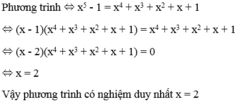
Hãy nhập câu hỏi của bạn vào đây, nếu là tài khoản VIP, bạn sẽ được ưu tiên trả lời.


1.
a/ \(\Leftrightarrow\left(x+1\right)\left(x^2+3x+2\right)+\left(x-1\right)\left(x^2-3x+2\right)-12=0\)
\(\Leftrightarrow\left(x+1\right)\left(x^2+2\right)+3x\left(x+1\right)-3x\left(x-1\right)+\left(x-1\right)\left(x^2+2\right)-12=0\)
\(\Leftrightarrow2x\left(x^2+2\right)+6x^2-12=0\)
\(\Leftrightarrow x^3+3x^2+2x-6=0\)
\(\Leftrightarrow\left(x-1\right)\left(x^2+4x+6\right)=0\Rightarrow x=1\)
b/ Nhận thấy \(x=0\) ko phải nghiệm, chia 2 vế cho \(x^2\)
\(x^2+\frac{1}{x^2}+3\left(x+\frac{1}{x}\right)+4=0\)
Đặt \(x+\frac{1}{x}=t\Rightarrow x^2+\frac{1}{x^2}=t^2-2\)
\(t^2-2+3t+4=0\Rightarrow t^2+3t+2=0\Rightarrow\left[{}\begin{matrix}t=-1\\t=-2\end{matrix}\right.\)
\(\Rightarrow\left[{}\begin{matrix}x+\frac{1}{x}=-1\\x+\frac{1}{x}=-2\end{matrix}\right.\) \(\Rightarrow\left[{}\begin{matrix}x^2+x+1=0\left(vn\right)\\x^2+2x+1=0\end{matrix}\right.\) \(\Rightarrow x=-1\)
1c/
\(\Leftrightarrow x^5+x^4-2x^4-2x^3+5x^3+5x^2-2x^2-2x+x+1=0\)
\(\Leftrightarrow x^4\left(x+1\right)-2x^3\left(x+1\right)+5x^2\left(x+1\right)-2x\left(x+1\right)+x+1=0\)
\(\Leftrightarrow\left(x+1\right)\left(x^4-2x^3+5x^2-2x+1\right)=0\)
\(\Leftrightarrow\left[{}\begin{matrix}x=-1\\x^4-2x^3+5x^2-2x+1=0\left(1\right)\end{matrix}\right.\)
\(\left(1\right)\Leftrightarrow x^4-2x^3+x^2+x^2-2x+1+3x^2=0\)
\(\Leftrightarrow\left(x^2-x\right)^2+\left(x-1\right)^2+3x^2=0\)
\(\Leftrightarrow\left\{{}\begin{matrix}x^2-x=0\\x-1=0\\x=0\end{matrix}\right.\) \(\Rightarrow\) không tồn tại x thỏa mãn
Vậy pt có nghiệm duy nhất \(x=-1\)

a) x = -1. b) x = 4 hoặc x = 5.
c) x = ± 2 . d) x = 1 hoặc x = 2.

a, \(\Leftrightarrow\left(9x^2-4\right)\left(x+1\right)-\left(3x+2\right)\left(x-1\right)\left(x+1\right)=0\)
\(\Leftrightarrow\left(x+1\right)\left(\left(9x^2-4\right)-\left(\left(3x+2\right)\left(x-1\right)\right)\right)=0\)
\(\Leftrightarrow\left(x+1\right)\left(9x^2-4-\left(3x^2-x-2\right)\right)=0\)
\(\Leftrightarrow\left(x+1\right)\left(9x^2-4-3x^2+x+2\right)=0\)
\(\Leftrightarrow\left(x+1\right)\left(3x^2+x-2\right)=0\)
\(\Leftrightarrow\left(x+1\right)=0;3x^2+x-2=0\)
=> x=-1
với \(3x^2+x-2=0\)
ta sử dụng công thức bậc 2 suy ra : \(x=\dfrac{2}{3};x=-1\)
Vậy ghiệm của pt trên \(S\in\left\{-1;\dfrac{2}{3}\right\}\)
b: \(\Leftrightarrow x^2-2x+1-1+x^2=x+3-x^2-3x\)
\(\Leftrightarrow2x^2-2x=-x^2-2x+3\)
\(\Leftrightarrow3x^2=3\)
hay \(x\in\left\{1;-1\right\}\)
c: \(\Leftrightarrow\left(x-1\right)\left(x+1\right)\left(x+2\right)\left(x-3\right)-\left(x-1\right)\left(x-2\right)\left(x+2\right)\left(x+5\right)=0\)
\(\Leftrightarrow\left(x-1\right)\left(x+2\right)\left[\left(x+1\right)\left(x-3\right)-\left(x-2\right)\left(x+5\right)\right]=0\)
\(\Leftrightarrow\left(x-1\right)\left(x+2\right)\left(x^2-2x-3-x^2-3x+10\right)=0\)
\(\Leftrightarrow\left(x-1\right)\left(x+2\right)\left(-5x+7\right)=0\)
hay \(x\in\left\{1;-2;\dfrac{7}{5}\right\}\)

Vì P(x) có hệ số bậc cao nhất là 1
Nên P(x) có thể được viết dưới dạng: \(P\left(x\right)=\left(x-x_1\right)\left(x-x_2\right)\left(x-x_3\right)\left(x-x_4\right)\left(x-x_5\right)\)
Và \(P\left(-1\right)=\left(-1\right)^5-5\left(-1\right)^3+4\left(-1\right)+1=1\)
\(P\left(\frac{1}{2}\right)=\frac{77}{32}\)
Ta có: \(Q\left(x\right)=2x^2+x-1=2x^2+2x-x-1=2x\left(x+1\right)-\left(x+1\right)=\left(x+1\right)\left(2x-1\right)\)
=> \(Q\left(x_1\right).\text{}\text{}Q\left(x_2\right).\text{}\text{}Q\left(x_3\right).\text{}\text{}Q\left(x_4\right).\text{}\text{}Q\left(x_5\right)\text{}\text{}\)
\(=\left(x_1+1\right)\left(2x_1-1\right)\left(x_2+1\right)\left(2x_2-1\right)\left(x_3+1\right)\left(2x_3-1\right)\left(x_4+1\right)\left(2x_4-1\right)\left(x_5+1\right)\left(2x_5-1\right)\)
\(=32\left(-1-x_1\right)\left(\frac{1}{2}-x_1\right)\left(-1-x_2\right)\left(\frac{1}{2}-x_2\right)\left(-1-x_3\right)\left(\frac{1}{2}-x_3\right)\left(-1-x_4\right)\left(\frac{1}{2}-x_4\right)\left(-1-x_5\right)\left(\frac{1}{2}-x_5\right)\)\(=32.P\left(-1\right).P\left(\frac{1}{2}\right)=32.1.\frac{77}{32}=77\)
\(p\left(x\right)=x^5-5x^3+4x+1=\left(x-x_1\right)\left(x-x_2\right)\left(x-x_3\right)\left(x-x_4\right)\left(x-x_5\right)\)
\(Q\left(x\right)=2\left(\frac{1}{2}-x\right)\left(-1-x\right)\)
Do đó \(Q\left(x_1\right)\cdot Q\left(x_2\right)\cdot Q\left(x_3\right)\cdot Q\left(x_4\right)\cdot Q\left(x_5\right)\)
\(=2^5\left[\left(\frac{1}{2}-x_1\right)\left(\frac{1}{2}-x_2\right)\left(\frac{1}{2}-x_3\right)\left(\frac{1}{2}-x_4\right)\left(\frac{1}{2}-x_5\right)\right]\)
\(=\left(-1-x_1\right)\left(-1-x_2\right)\left(-1-x_3\right)\left(-1-x_4\right)\left(-1-x_5\right)\)
\(=32P\left(\frac{1}{2}\right)\cdot\left[P\left(-1\right)\right]\)
\(=32\cdot\left(\frac{1}{32}-\frac{5}{8}+\frac{4}{2}+1\right)\left(-1+5-4+1\right)\)
\(=4300\)
*Mình không chắc*

Ta có
x 4 + 4 x 3 + 4 x 2 = 0
⇔ x 2 x 2 + 4 x + 4 = 0
⇔ x 2 x + 2 2 = 0 ⇔ x 2 = 0 x + 2 2 = 0
⇔ x = 0 x + 2 = 0 ⇔ x = 0 x = - 2
Vậy x = 0; x = -2
Đáp án cần chọn là: C



ta có x.(5+4-3+2-1)+2=0
=> x.7=-2
=> x=-2/7
vậy x=-2/7